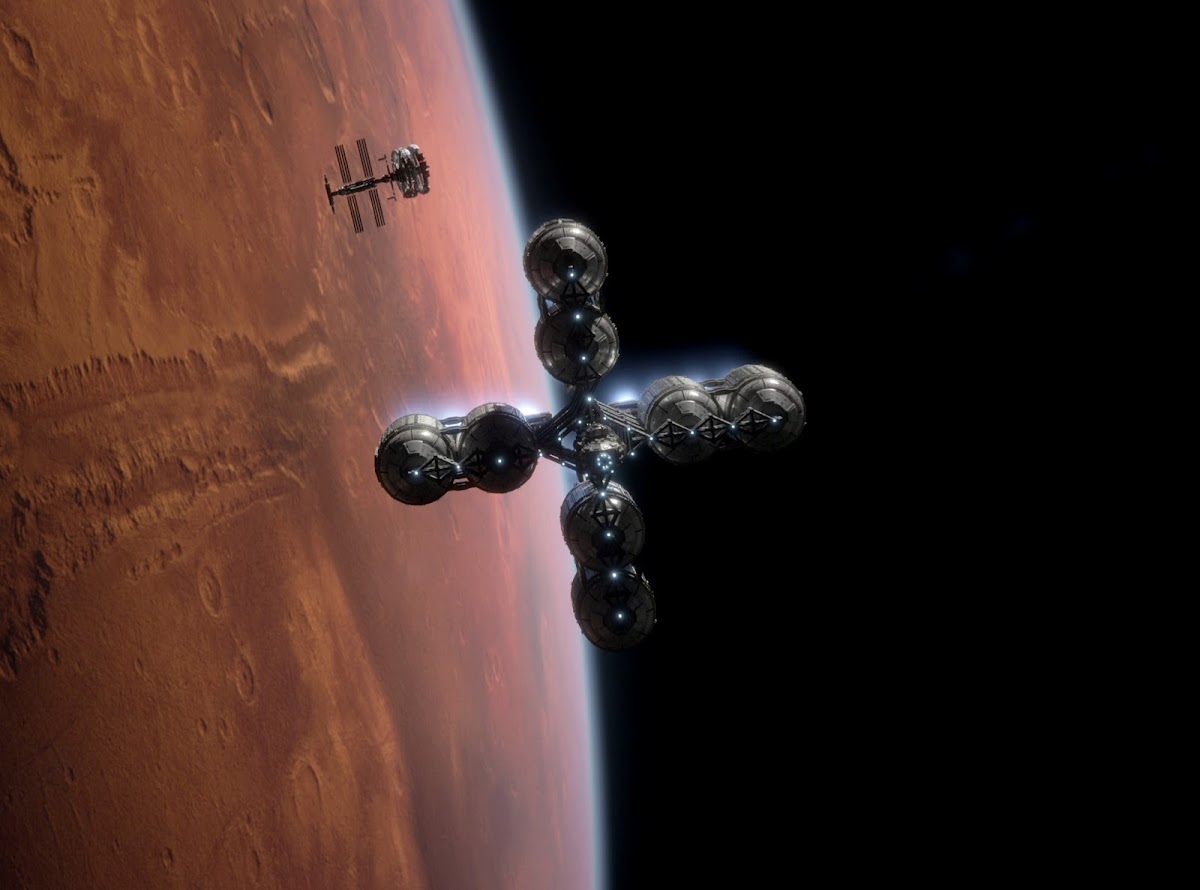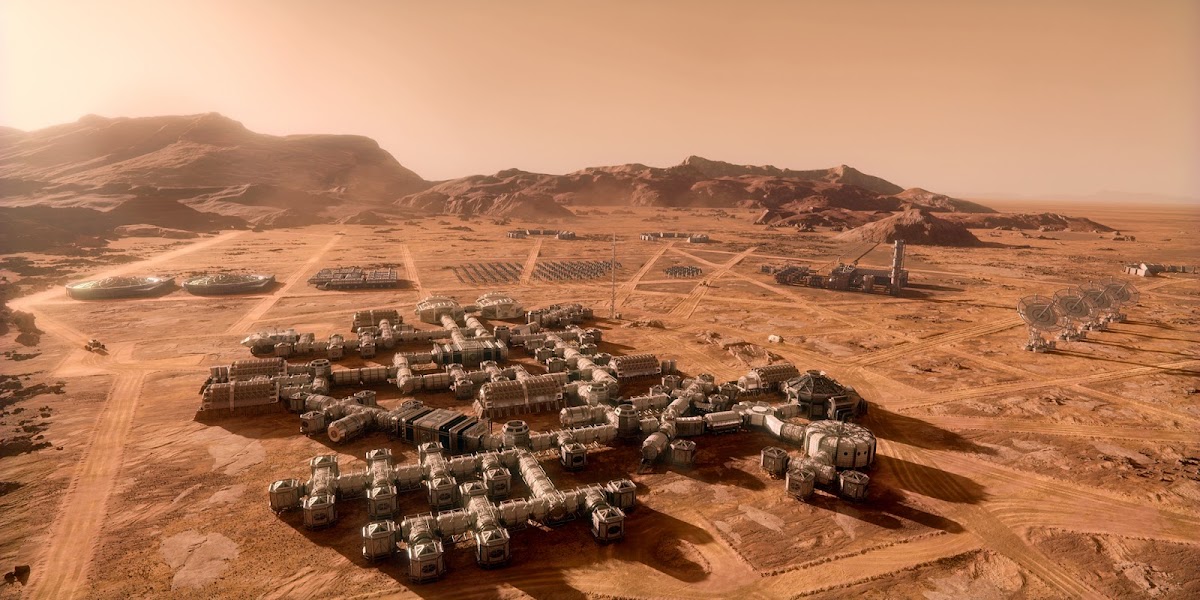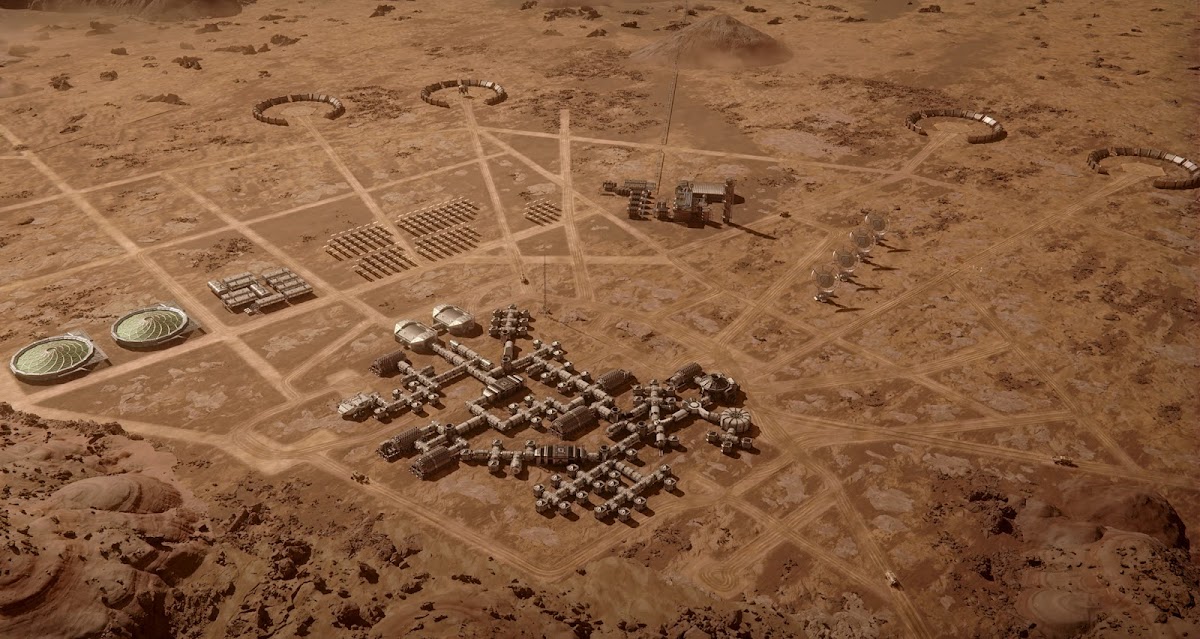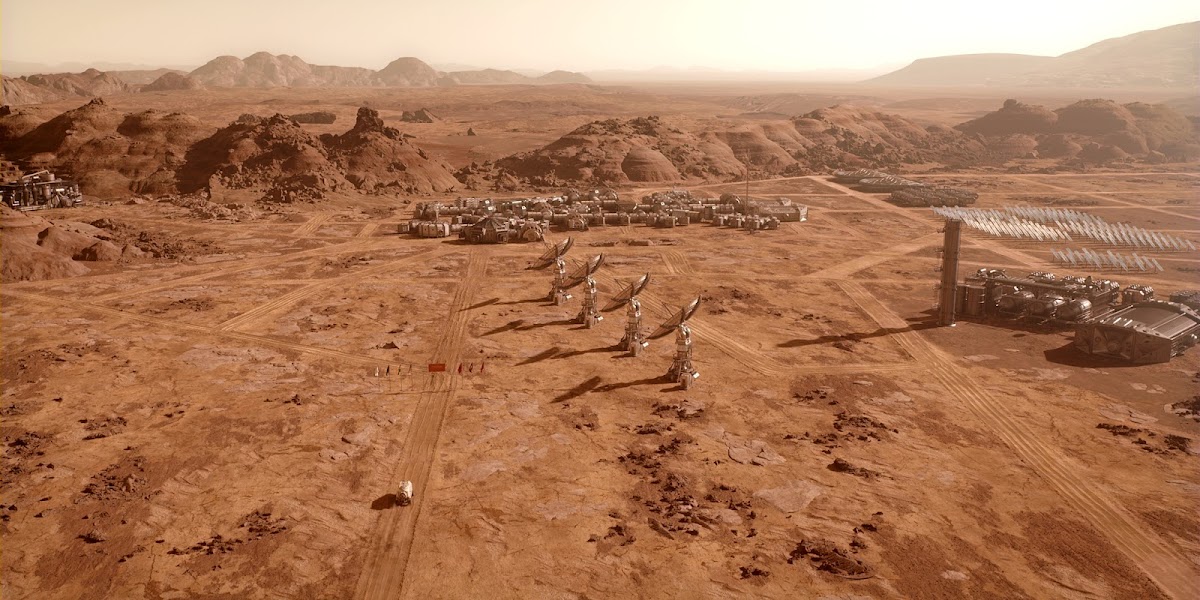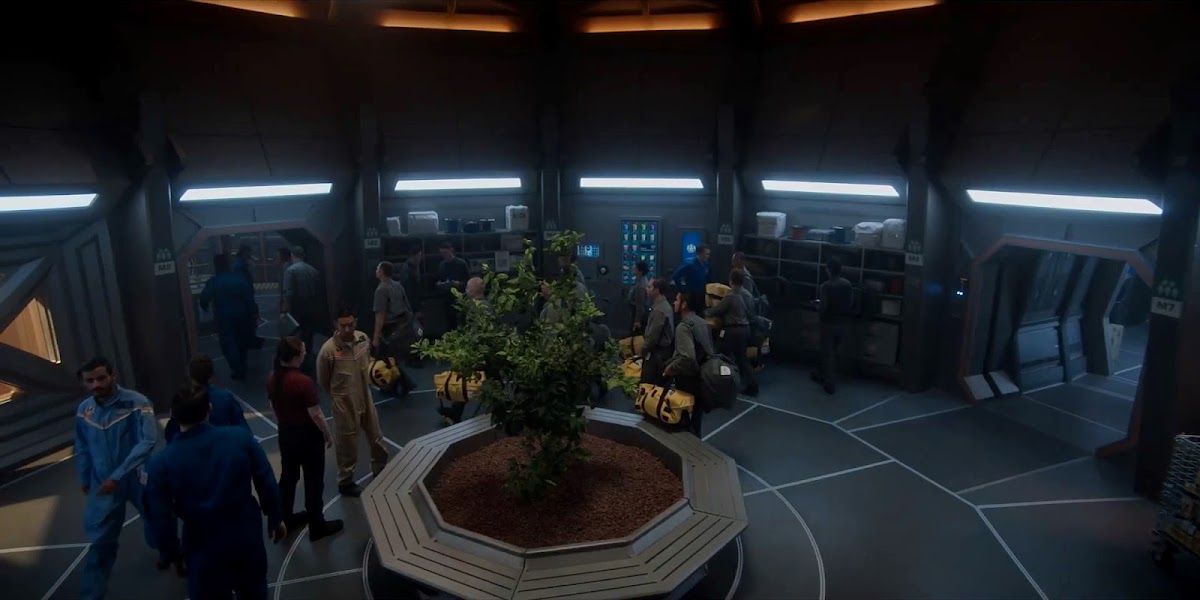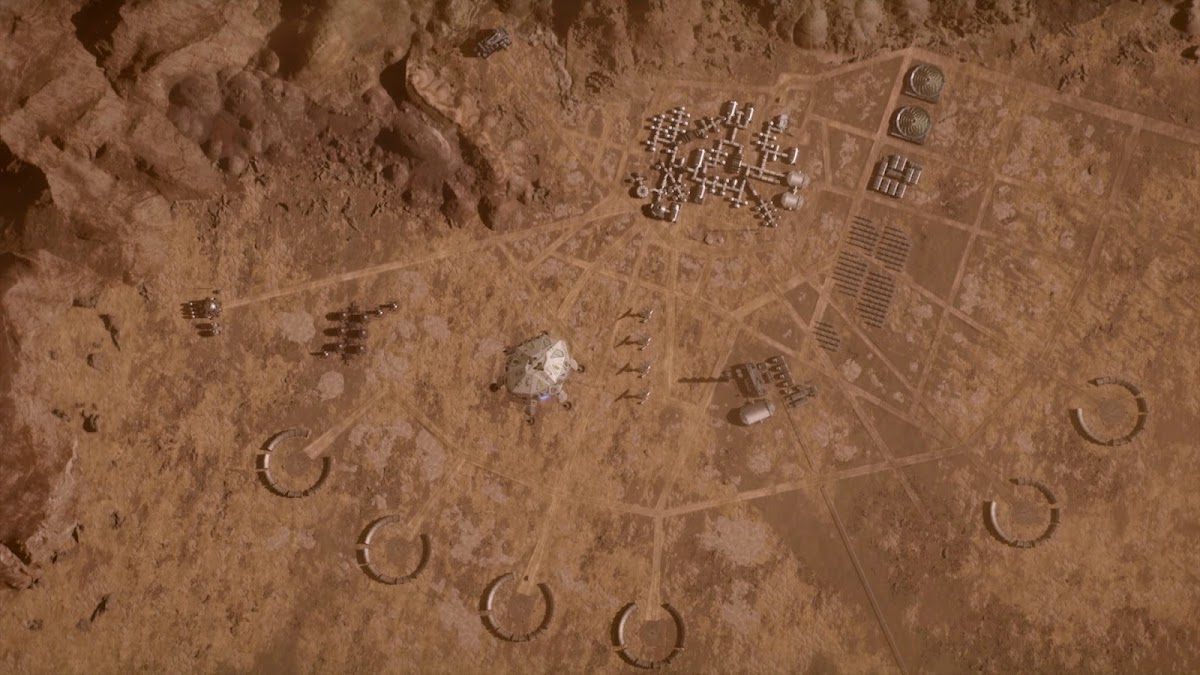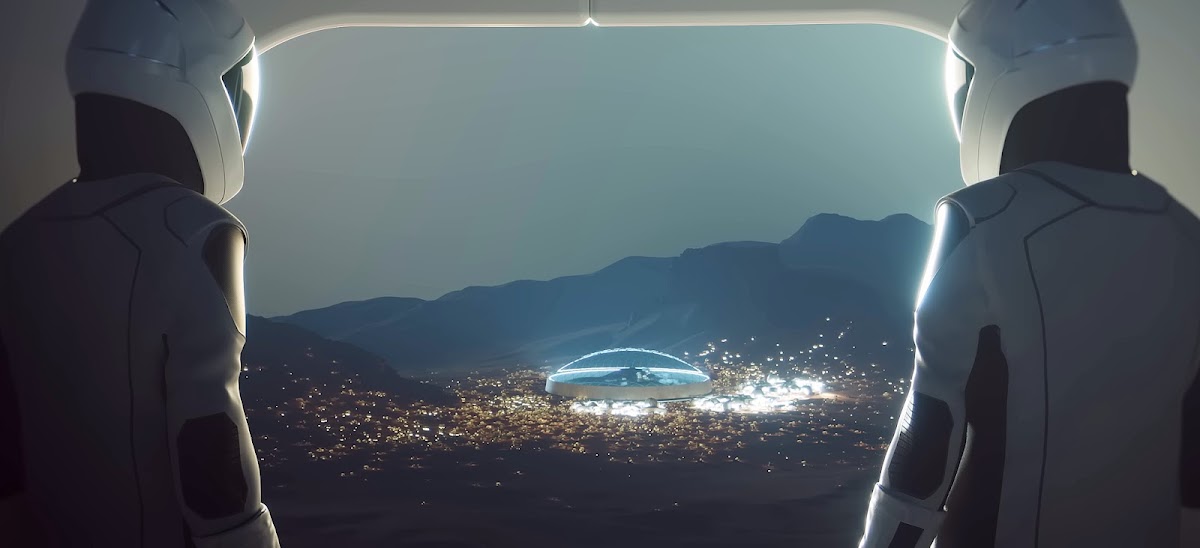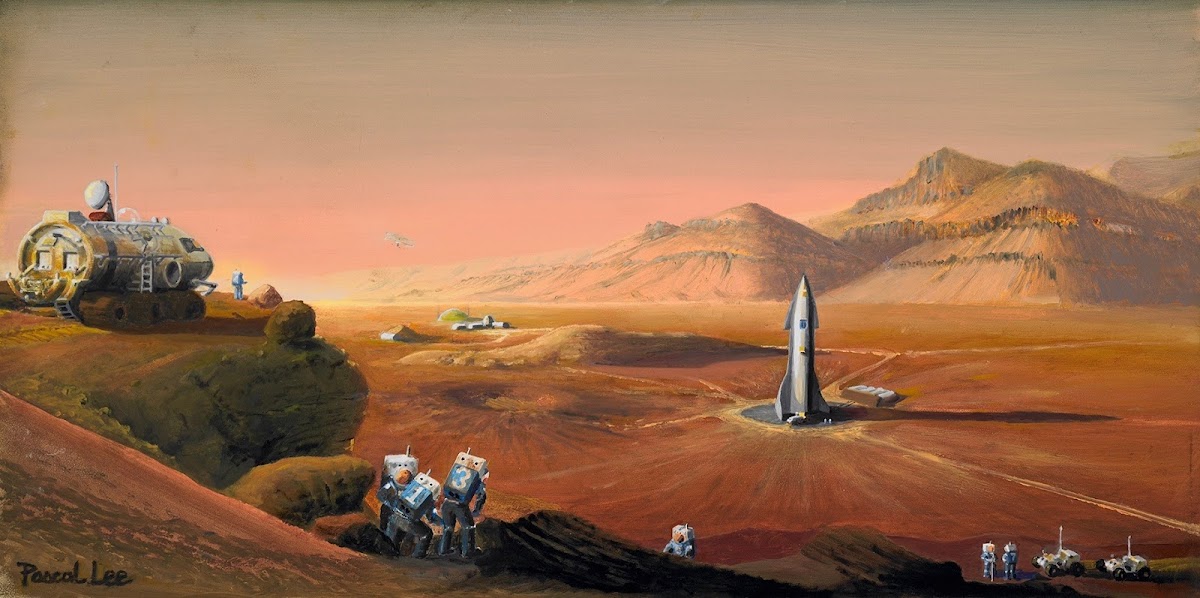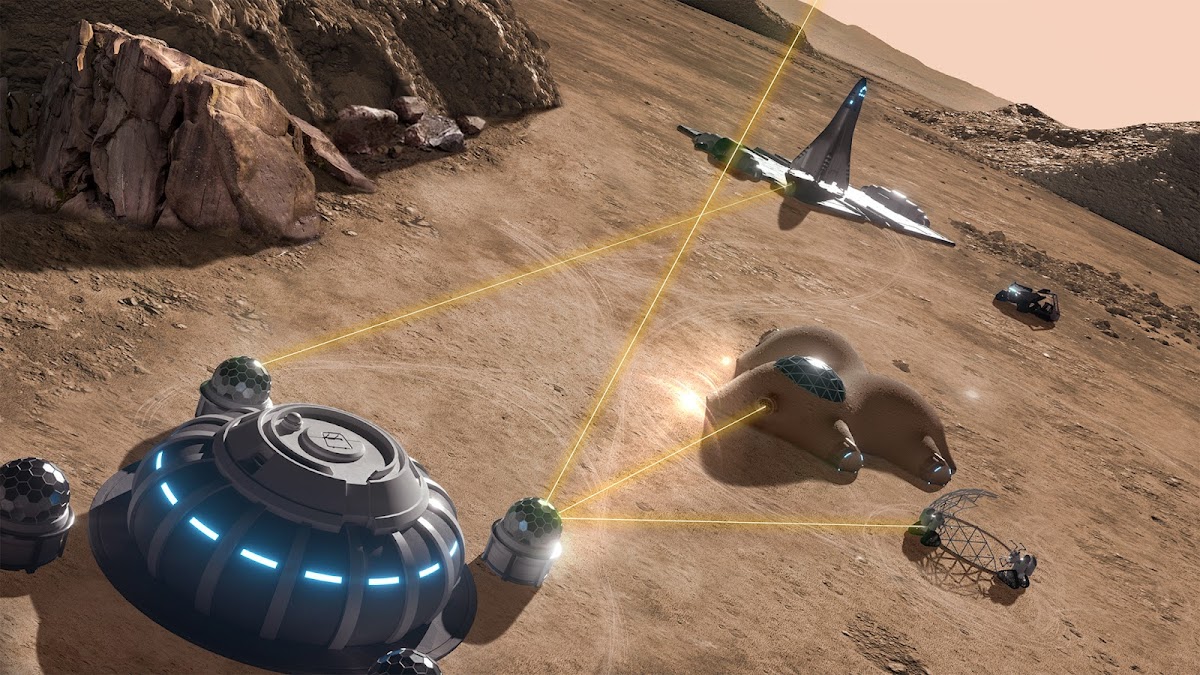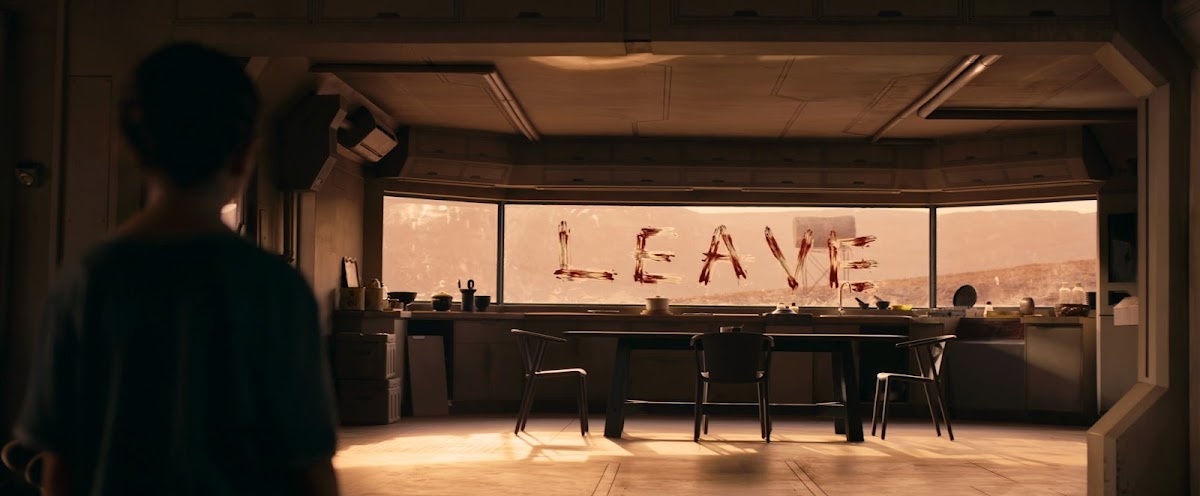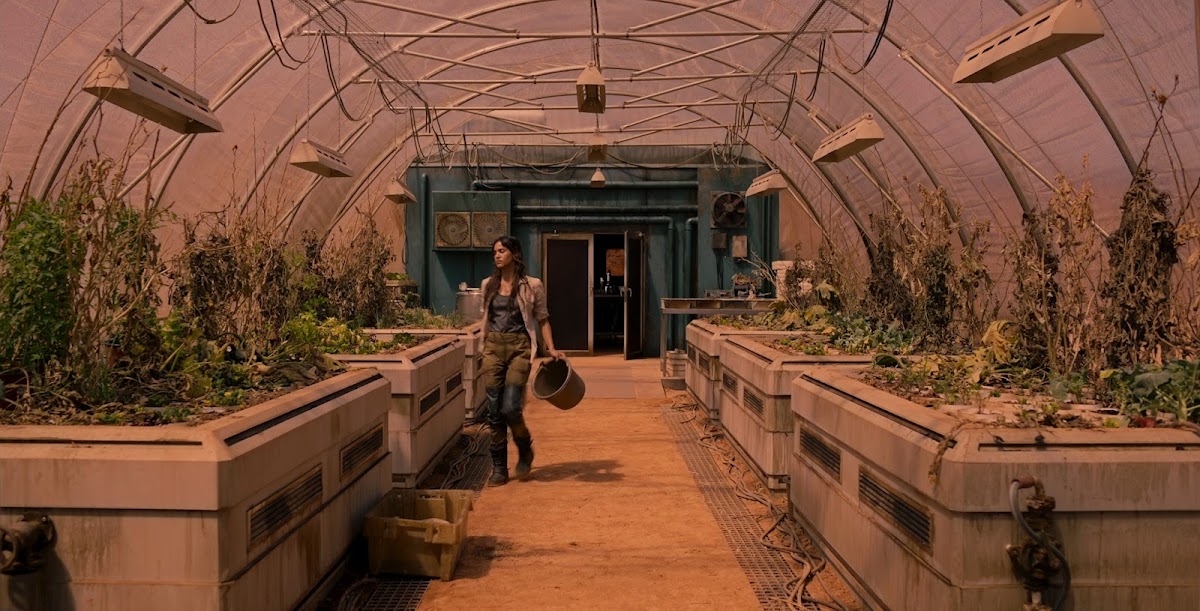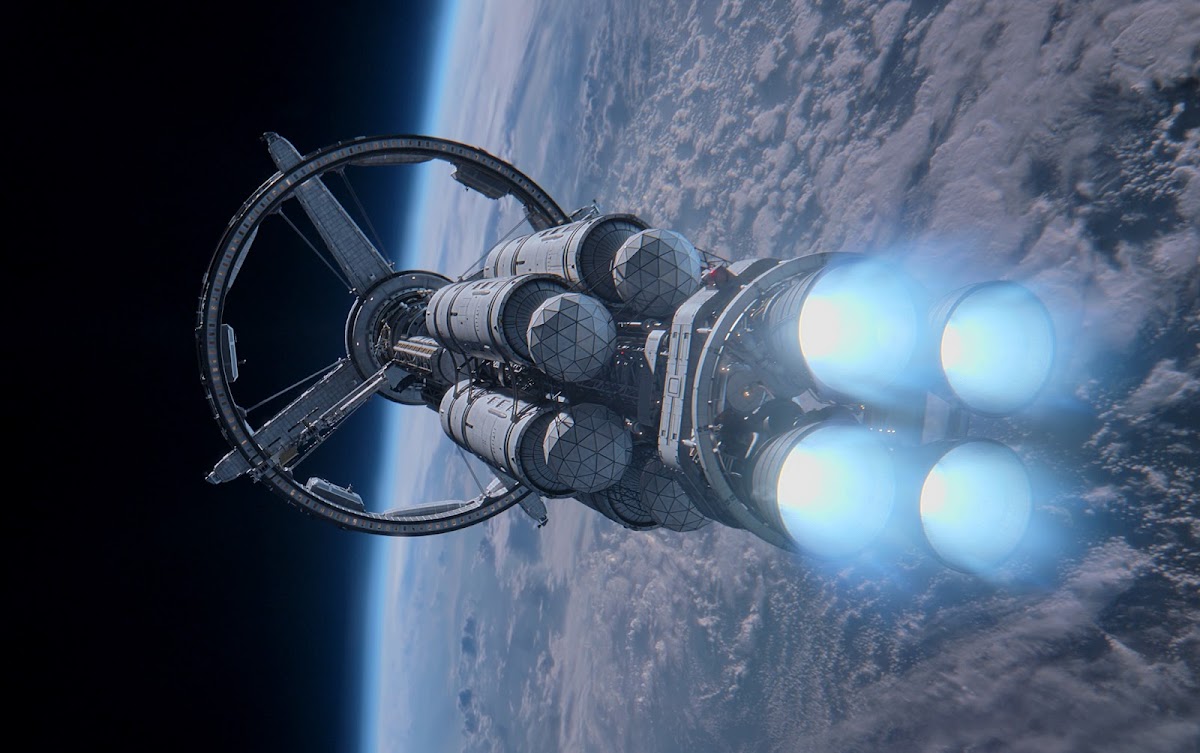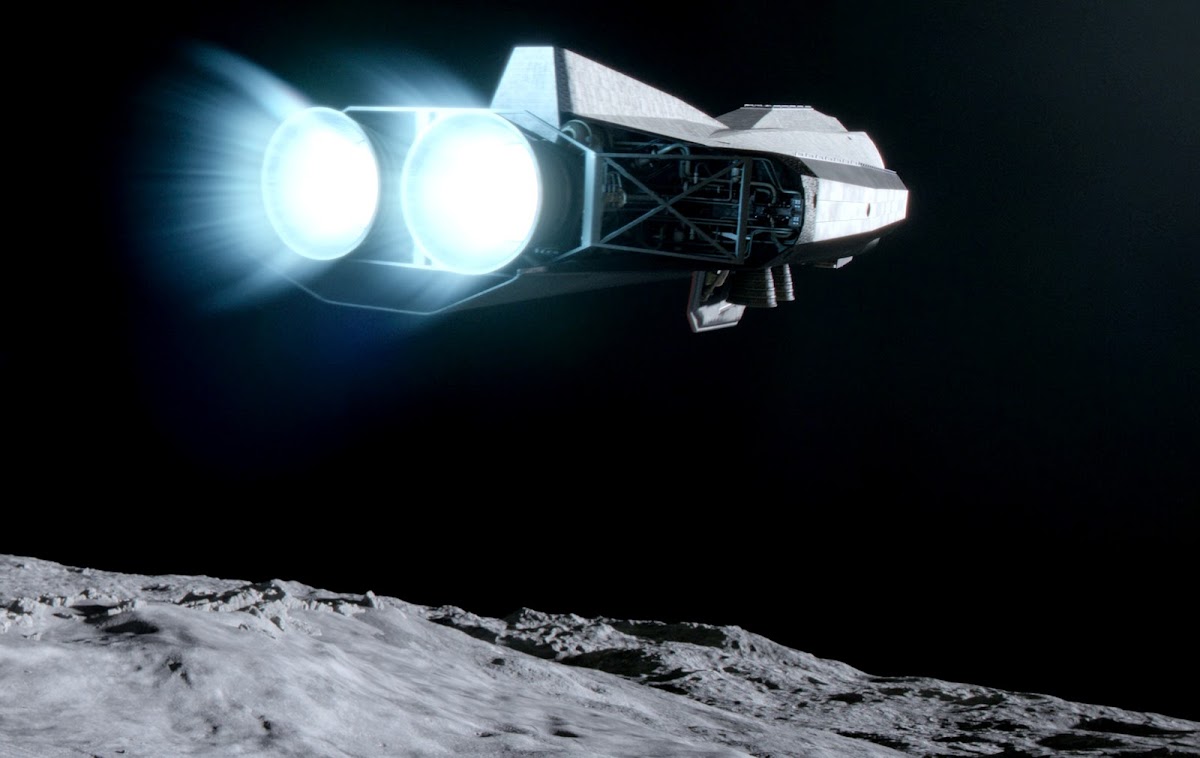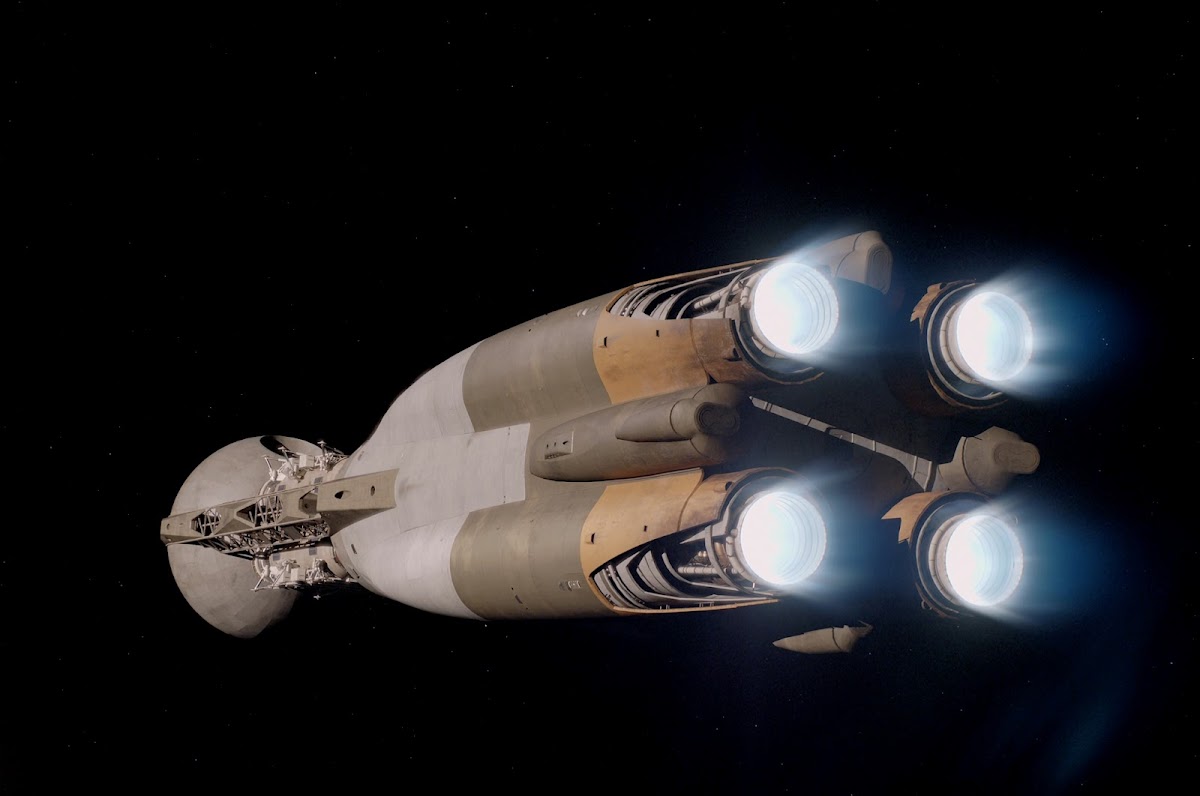Canadian concept artist Bryan Versteeg has created a concept of a human base on Mars featuring a recreational garden inside a small crater covered with a transparent dome.
Showing posts with label Mars Base. Show all posts
Showing posts with label Mars Base. Show all posts
Saturday, September 28, 2024
Saturday, August 3, 2024
The colonization of Mars in "The Martian Chronicles" (1980) TV series
The Martian Chronicles is a 1980 television 3-episode miniseries based on Ray Bradbury's 1950 science fiction novel with the same name The Martian Chronicles which was originally not written as a singular work but as short stories published separately in late 1940s.
The novel and TV series chronicles the exploration and settlement of Mars, the home of indigenous Martians, at the beginning of 21st century when human settlers leave the troubled Earth that is eventually devastated by a nuclear war. The series depicts Mars as having a "thin atmosphere" which humans can breathe, with desert-like vegetation and water-filled canals, cities and other alien structures built by the indigenous Martians thousands of years ago.
The Martian Chronicles TV series, aired on 1980, is one of the few works of science fiction to depict Mars, in the period between the initial Mars enthusiasm that ended in the 1960s, characterized by fear of hostile Martians, and the revival of Mars-related science fiction in the 2000s already without the Martians.
The Martian Chronicles are divided into three parts / episodes:
The novel and TV series chronicles the exploration and settlement of Mars, the home of indigenous Martians, at the beginning of 21st century when human settlers leave the troubled Earth that is eventually devastated by a nuclear war. The series depicts Mars as having a "thin atmosphere" which humans can breathe, with desert-like vegetation and water-filled canals, cities and other alien structures built by the indigenous Martians thousands of years ago.
The Martian Chronicles TV series, aired on 1980, is one of the few works of science fiction to depict Mars, in the period between the initial Mars enthusiasm that ended in the 1960s, characterized by fear of hostile Martians, and the revival of Mars-related science fiction in the 2000s already without the Martians.
The Martian Chronicles are divided into three parts / episodes:
- The Expeditions - the exploration of Mars begins with two failed expeditions. Colonel Wilder then leads a 3rd crew to discover the secret of Mars - only to find all the Martians dead from chicken pox.
- The Settlers - with native Martians wiped out by disease, thousands of humans now colonize the red planet and attempt to create a second Earth.
- The Martians - with Earth destroyed in a nuclear war, there are only a few survivors on Mars, including Wilder's family. To rebuild what he has lost, Wilder chooses to make Mars his new home.
First expeditions to Mars:
Saturday, July 20, 2024
A long night on Mars in "Fort Solis" thriller game
Fort Solis (2023) is a cinematic narrative-driven science fiction thriller game set in 2080 on Mars. During a night engulfed in a severe sandstorm two mining engineers, Jack and Jessica, respond to an unusual emergency alert from a mining and research station "Fort Solis". The station is on lockdown and seems to be abandoned. The pair separately starts to investigate, what has happened in the base, searching for clues throughout the claustrophobic buildings. Piece by piece they unlock both the various parts of the base and the truth behind recent events there. The game starts as a detective and ends as a thriller.
Fort Solis runs on Unreal Engine 5.2 so visually it is really good, especially the character models and animations. The game is not long, you can finish it in 5 to 8 hours even when reading, watching and listening to all of the clues throughout the base. The story will unfold linearly piece by piece, but there are two separate endings possible in the final act of the game.
Fort Solis runs on Unreal Engine 5.2 so visually it is really good, especially the character models and animations. The game is not long, you can finish it in 5 to 8 hours even when reading, watching and listening to all of the clues throughout the base. The story will unfold linearly piece by piece, but there are two separate endings possible in the final act of the game.
Visual recap of Fort Solis' STORY
Jack and Jessica are working at a mining rig on Mars
When receiving the emergency allert Jack is driving to the mining station "Fort Solis"
"Fort Solis" is on lockdown
Sunday, January 14, 2024
How to steal an asteroid .. "For All Mankind" season 4
It's possible our judgement is biased towards Mars-related content, but season 4 of For All Mankind alternate history sci-fi TV series is show's most exciting season yet. In season 4, depicting the alternate 2003, the international Happy Valley Base, founded in 1995 during season 3, has been significantly expanded and there are around 200 people living in it. We made a separate article with a large collection of high resolution shots depicting the exterior and interior of Happy Valley Base:
Mars base for 200 people in For All Mankind season 4
The main theme in season 4 is increasingly diverging visions for the purpose of human presence on Mars. For some it's only another contract job, but for others Mars is a new place to call "home". Add to the mix a once-in-a-lifetime opportunity to get hold on a large lithium-rich asteroid and increasingly strained relationships between the "upper class" (astronauts / cosmonauts, scientists and top executives) and contract workers literally living underground, and you have a recipe for a "Martian rebellion".
For All Mankind is exploring the idea of never ending space race if Soviets would have beaten US in the race for the Moon and the intention of the show is each season to jump about a decade further into the increasingly diverging reality of the show: in season 1, depicting alternate 1969 to 1974, both Soviets and US start building their separate bases near the lunar South pole; in season 2 (1983) both bases have been expanded and the superpowers compete for resources on the Lunar surface; in season 3 (1992 to 1995), Soviets and US are joined by a private company Helios and North Korea for a four way race to be first on Mars; in season 4 (2003) there is a sprawling international human base on Mars and an unexpected side enters the race to get hold on a large, lithium-rich asteroid for mining. You can watch the show on Apple TV+
Ahead there is a VISUAL RECAP OF SEASON 4, consisting of high resolution shots, downscaled from 4K UHD screens for better image quality. Be aware of heavy spoilers, revealing major story plots:
Mars base for 200 people in For All Mankind season 4
The main theme in season 4 is increasingly diverging visions for the purpose of human presence on Mars. For some it's only another contract job, but for others Mars is a new place to call "home". Add to the mix a once-in-a-lifetime opportunity to get hold on a large lithium-rich asteroid and increasingly strained relationships between the "upper class" (astronauts / cosmonauts, scientists and top executives) and contract workers literally living underground, and you have a recipe for a "Martian rebellion".
For All Mankind is exploring the idea of never ending space race if Soviets would have beaten US in the race for the Moon and the intention of the show is each season to jump about a decade further into the increasingly diverging reality of the show: in season 1, depicting alternate 1969 to 1974, both Soviets and US start building their separate bases near the lunar South pole; in season 2 (1983) both bases have been expanded and the superpowers compete for resources on the Lunar surface; in season 3 (1992 to 1995), Soviets and US are joined by a private company Helios and North Korea for a four way race to be first on Mars; in season 4 (2003) there is a sprawling international human base on Mars and an unexpected side enters the race to get hold on a large, lithium-rich asteroid for mining. You can watch the show on Apple TV+
Ahead there is a VISUAL RECAP OF SEASON 4, consisting of high resolution shots, downscaled from 4K UHD screens for better image quality. Be aware of heavy spoilers, revealing major story plots:
During season 4 interplanetary ships don't land directly on Mars; instead they dock to Phoenix, orbiting Mars, and the rest of the trip is made via small shuttles heading down to the surface:
Ed and Svetlana flying the asteroid capture ship Ranger:
Season 4 starts with an unsuccessful asteroid capture mission:
Wednesday, January 10, 2024
Mars base for 200 people in "For All Mankind" season 4
Season 4 of For All Mankind alternate history sci-fi TV series, depicting alternate 2003, "is really about the building of a new civilization on Mars" by the words of the co-creator of the series Ben Nedivi. The international Happy Valley Base, founded in 1995 during season 3 and located in Melas Chasma in the Valles Marineris canyon system on Mars, has been significantly expanded and there are around 200 people living in the base during season 4. The base is financed and operated by Mars-7 Alliance (consisting of US, USSR, ESA, North Korea, India, Japan, and the Coalition of Communist Countries for Spaceflight (CCCS)) and maintained by a private company Helios Aerospace.
Ground level of the base features several separate facilities for power generation, communications, fuel refinement, regolith processing, algae production, storage etc. and a central interconnected cluster of modules consisting of the Entrance hall for new arrivals with airlocks for the rovers, control rooms, laboratories, hydroponic farms, meeting rooms, warehouses / garages, a cafeteria, as well as the quarters for higher level personnel and astronauts / cosmonauts. The base has 5 underground sublevels, of which level 4 & 5 are still under construction in 2003 and not accessible. The sublevels house maintenance and storage rooms and additional quarters for workers. There is also a separate North Korean sector accessible only to North Koreans. The base also operates six landing pads for their orbital Hopper shuttles.
The design of the Happy Valley Base in For All Mankind is the most plausible design of a mid-sized human base on Mars that we have ever seen in a TV series or film.
For All Mankind is exploring the idea of never ending space race if Soviets would have beaten US in the race for the Moon and the intention of the show is each season to jump about a decade further into the increasingly diverging reality of the show: in season 1, depicting alternate 1969 to 1974, both Soviets and US start building their separate bases near the lunar South pole; in season 2 (1983) both bases have been expanded and the superpowers compete for resources on the Lunar surface; in season 3 (1992 to 1995), Soviets and US are joined by a private company Helios and North Korea for a four way race to be first on Mars; in season 4 (2003) there is a sprawling international human base on Mars and an unexpected side enters the race to get hold on a large, lithium-rich asteroid for mining.
Here we collected high resolution shots from season 4 (downscaled from 4K UHD screens for better image quality) depicting the exterior and interior of Happy Valley Base on Mars. No images revealing major story plots are included. We will make a separate article with season 4 story spoilers after the last episode will be released on January 12. [UPDATED:]
How to steal an asteroid .. "For All Mankind" season 4
Ground level of the base features several separate facilities for power generation, communications, fuel refinement, regolith processing, algae production, storage etc. and a central interconnected cluster of modules consisting of the Entrance hall for new arrivals with airlocks for the rovers, control rooms, laboratories, hydroponic farms, meeting rooms, warehouses / garages, a cafeteria, as well as the quarters for higher level personnel and astronauts / cosmonauts. The base has 5 underground sublevels, of which level 4 & 5 are still under construction in 2003 and not accessible. The sublevels house maintenance and storage rooms and additional quarters for workers. There is also a separate North Korean sector accessible only to North Koreans. The base also operates six landing pads for their orbital Hopper shuttles.
The design of the Happy Valley Base in For All Mankind is the most plausible design of a mid-sized human base on Mars that we have ever seen in a TV series or film.
For All Mankind is exploring the idea of never ending space race if Soviets would have beaten US in the race for the Moon and the intention of the show is each season to jump about a decade further into the increasingly diverging reality of the show: in season 1, depicting alternate 1969 to 1974, both Soviets and US start building their separate bases near the lunar South pole; in season 2 (1983) both bases have been expanded and the superpowers compete for resources on the Lunar surface; in season 3 (1992 to 1995), Soviets and US are joined by a private company Helios and North Korea for a four way race to be first on Mars; in season 4 (2003) there is a sprawling international human base on Mars and an unexpected side enters the race to get hold on a large, lithium-rich asteroid for mining.
Here we collected high resolution shots from season 4 (downscaled from 4K UHD screens for better image quality) depicting the exterior and interior of Happy Valley Base on Mars. No images revealing major story plots are included. We will make a separate article with season 4 story spoilers after the last episode will be released on January 12. [UPDATED:]
How to steal an asteroid .. "For All Mankind" season 4
Wednesday, November 8, 2023
Building a new civilization on Mars in "For All Mankind" season 4
 Yesterday Apple TV+ released yet another video revealing more details about the upcoming season 4 of For All Mankind alternate history sci-fi TV series. As the co-creator of the series Ben Nedivi states in this featurette: "This season is really about the building of a new civilization on Mars. Last year in season 3 you saw the first explorers arrive on Mars. This season you're actually seeing hundreds of people up there and you're seeing, how civilization becomes civilization".
Yesterday Apple TV+ released yet another video revealing more details about the upcoming season 4 of For All Mankind alternate history sci-fi TV series. As the co-creator of the series Ben Nedivi states in this featurette: "This season is really about the building of a new civilization on Mars. Last year in season 3 you saw the first explorers arrive on Mars. This season you're actually seeing hundreds of people up there and you're seeing, how civilization becomes civilization".
Judging from the reviews by journalists who were given early access to the first 7 episodes of season 4, this season might be the show's most exciting season yet. We look forward to judging it for ourselves. Season 4 premieres November 10 on Apple TV+, with episodes releasing weekly.
Some of the details for season 4 were previously revealed in a teaser and a trailer.
For All Mankind is exploring the idea of never ending space race if Soviets would have beaten US in the race for the Moon and the intention of the show is each season to jump about a decade further into the increasingly diverging reality of the show: in season 1, depicting alternate 1969 to 1974, both Soviets and US start building their separate bases near the lunar South pole; in season 2 (1983) both bases have been expanded and the superpowers compete for resources on the Lunar surface; in season 3 (1992 to 1995), Soviets and US are joined by a private company Helios and North Korea for a four way race to establish the first human base on Mars.
Here are some HD images from the featurette above.
Happy Valley base on Mars:
Friday, October 13, 2023
Asteroid mining will play a major role in "For All Mankind" season 4
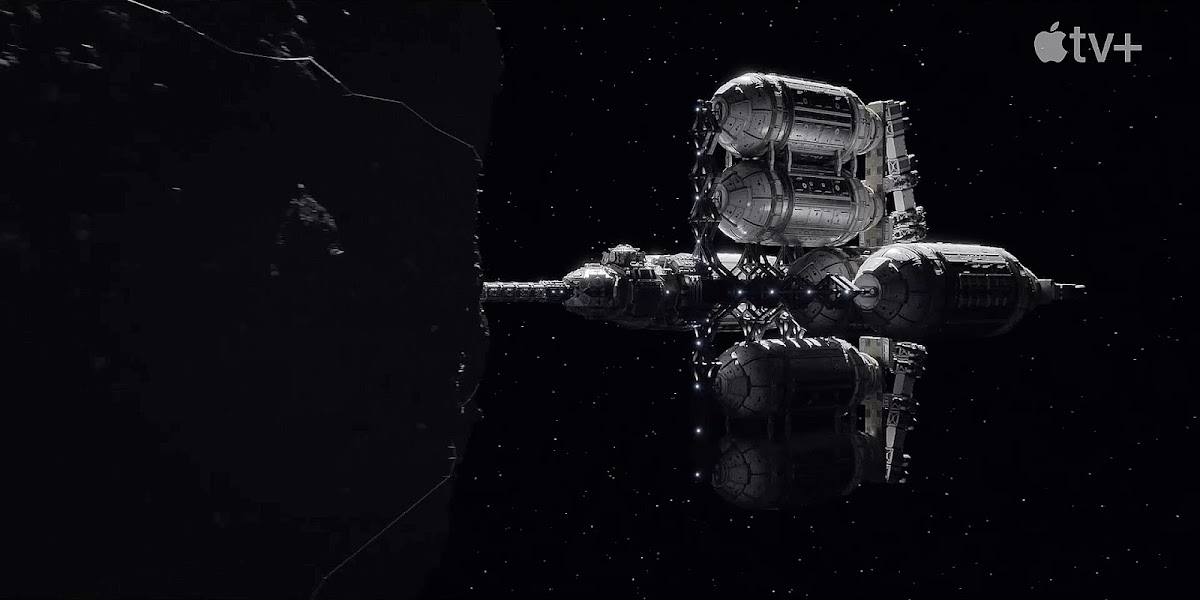 Yesterday Apple TV+ published a yet unlisted trailer for season 4 of For All Mankind alternate history sci-fi TV series, revealing asteroid mining will play a major role in season 4, set in 2003. The trailer also revealed more details about the soon-to-be "self-sustaining" international Happy Valley base on Mars, first depicted in the first teaser for season 4 a month ago.
Yesterday Apple TV+ published a yet unlisted trailer for season 4 of For All Mankind alternate history sci-fi TV series, revealing asteroid mining will play a major role in season 4, set in 2003. The trailer also revealed more details about the soon-to-be "self-sustaining" international Happy Valley base on Mars, first depicted in the first teaser for season 4 a month ago.
For All Mankind is exploring the idea of never ending space race if Soviets would have beaten US in the race for the Moon and the intention of the show is each season to jump about a decade further into the increasingly diverging reality of the show: in season 1, depicting alternate 1969 to 1974, both Soviets and US start building their separate bases near the lunar South pole; in season 2 (1983) both bases have been expanded and the superpowers compete for resources on the Lunar surface; in season 3 (1992 to 1995), Soviets and US are joined by a private company Helios and North Korea for a four way race to establish the first human base on Mars. Season 4 will start airing on November 10 on Apple TV+ and will depict the alternate 2003.
Here you can watch the trailer and see some HD images from it:
Happy Valley base on Mars:
Friday, September 15, 2023
"For All Mankind" season 4 reveals a sprawling first human base on Mars
 On September 13 Apple TV+ released the first teaser for season 4 of For All Mankind alternate history sci-fi TV series. The teaser is made in the form of a recruitment ad for Helios Aerospace and reveals in season 4 of the show the company acts as a private operator and transport provider for the international Happy Valley base on Mars. Quite a resemblance to SpaceX in our reality 😉
On September 13 Apple TV+ released the first teaser for season 4 of For All Mankind alternate history sci-fi TV series. The teaser is made in the form of a recruitment ad for Helios Aerospace and reveals in season 4 of the show the company acts as a private operator and transport provider for the international Happy Valley base on Mars. Quite a resemblance to SpaceX in our reality 😉
For All Mankind is exploring the idea of never ending space race if Soviets would have beaten US in the race for the Moon and the intention of the show is each season to jump about a decade further into the increasingly diverging reality of the show: in season 1, depicting alternate 1969 to 1974, both Soviets and US start building their separate bases near the lunar South pole; in season 2 (1983) both bases have been expanded and the superpowers compete for resources on the Lunar surface; in season 3 (1992 to 1995), Soviets and US are joined by a private company Helios and North Korea for a four way race to establish the first human base on Mars. Season 4 will start airing on November 10 on Apple TV+ and will depict the alternate 2003 or so.
Here you can watch the teaser and see some HD images from it:
Helios recruitment posters:
Happy Valley Base overview:
Saturday, July 8, 2023
Mars. Welcome to paradise
Family walking around a human outpost on Mars in a vintage style poster "Mars. Welcome to paradise" by British freelance illustrator Mark Bell.
Tuesday, April 11, 2023
SpaceX Starship landing on Mars - 4K UHD renders from Elon's Starship update 2022
When SpaceX CEO and lead designer Elon Musk gave his latest Starship update in February 2022, the presentation contained an animation of Starship's mission to Mars with a landing at Mars Base Alpha in the end. Today SpaceX finally gave public access to 4K UHD version of that animation. Here are some images from it.
Starship landing at Mars Base Alpha:
Click HERE for 4K UHD resolution
Click HERE for 4K UHD resolution
Click HERE for 4K UHD resolution
Starship approaching Mars:
Click HERE for 4K UHD resolution
Saturday, February 18, 2023
SpaceX Starship at a small outpost on Mars by iamVisual
Sunday, February 5, 2023
Retrofuturistic Mars exploration base by Pascal Lee
In 2021 planetary scientist, the director of Haughton-Mars Project, Pascal Lee created a painting with the same, slightly updated scene of the first human exploration mission on Mars as in Chesley Bonestell's famous painting "Exploring Mars" featured in the 1956 book "The Exploration of Mars" by Willy Ley and Wernher Von Braun.
Highlighting Bonestell's legacy, Pascal Lee wrote: "In painting this new "Exploring Mars", I wanted to pay tribute to the grand master of space art and his creation of an iconic classic, but also update elements of the landscape and hardware in light of new knowledge gained about Mars in the intervening 65 years and evolutions in our thinking about future Mars exploration systems and human surface operations."
Highlighting Bonestell's legacy, Pascal Lee wrote: "In painting this new "Exploring Mars", I wanted to pay tribute to the grand master of space art and his creation of an iconic classic, but also update elements of the landscape and hardware in light of new knowledge gained about Mars in the intervening 65 years and evolutions in our thinking about future Mars exploration systems and human surface operations."
Comparison of Bonestell's (1956) and Lee's (2021) "Exploring Mars":
Friday, December 30, 2022
Lockheed Martin's vision for Mars base in 2050
At its "Destination: Space 2050" event in October Lockheed Martin (one of the largest American aerospace, advanced technologies and defense companies) shared its vision of a vibrant space economy in the year 2050. Here Lockheed Martin envisions a future on Mars with "power beaming, laser communications and robotic in-situ construction for a sustainable living and economic environment". Note company's conceptual Mars lander on the landing pad.
Lockheed Martin's animation of "Destination: Space 2050" vision:
Sunday, October 30, 2022
Desolate life at a homestead on Mars in Settlers (2021) movie
Settlers (2021) is a British science fiction thriller set in a Martian frontier. A small family of early settlers live alone at a homestead in a valley protected by a force field bubble that keeps breathable air inside, but soon their lonely existence is disturbed by a group of intruders. I won't spoil the plot twists of the thriller, but it has major Wild West vibes there. Here is a collection of HD screens from the movie:
Tuesday, August 16, 2022
"For All Mankind" season 3 brings space race to Mars
Soviets and US are joined by a private company Helios for a three way race to Mars in the alternate 1990s of For All Mankind season 3. The alternate history sci-fi TV series are exploring the idea of never ending space race if Soviets would have beaten US in the race for the Moon. In first two seasons of the show the focus was the Moon: in season 1, depicting alternate 1969 to 1974, both Soviets and US start building their separate bases near the lunar South pole; in season 2, depicting the alternate 1983, both bases have been expanded and the superpowers compete for resources on the Lunar surface.
The intention of the show is each season to jump about a decade further into the increasingly diverging reality of the show. Season 3 depicts alternate 1992 to 1995 when a race to establish first human base on Mars is facing various dangers for all of the participants. Here is a large collection of HD images from season 3 of the show. First part of the collection contains images with only minor spoilers, not revealing major story plots besides those already known from season 3 trailer.
The intention of the show is each season to jump about a decade further into the increasingly diverging reality of the show. Season 3 depicts alternate 1992 to 1995 when a race to establish first human base on Mars is facing various dangers for all of the participants. Here is a large collection of HD images from season 3 of the show. First part of the collection contains images with only minor spoilers, not revealing major story plots besides those already known from season 3 trailer.
The actual race starts with Helio's Phoenix launching from low Earth orbit, NASA's Sojourner from the Moon and Soviet Mars-94 directly from Earth:
Subscribe to:
Posts (Atom)


















